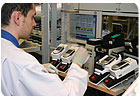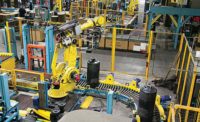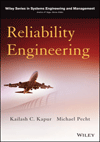
When designing an MEOST process, engineers must decide which stresses are likely to affect the assembly simultaneously. Photo courtesy Nokia Corp.
In his book World Class Reliability, published in 2004 by the American Management Association, Keki R. Bhote details a unique methodology for smoking out the weak links in an assembly: multiple environmental overstress testing (MEOST).
The objective of MEOST is not to pass a product, but fail it, says Bhote, who spent 42 years as an engineer with Motorola Inc. and is now president of his own eponymous consulting firm in Glencoe, IL. The idea behind MEOST is that testing products by exposing them to only one environmental variable-heat, for example-is not enough to uncover weaknesses. Rather, several stresses must be combined to replicate the conditions to which the product will be exposed. Moreover, the combined stresses must go well beyond design limits to a maximum practical overstress limit.
The latter point is important, because the degree of stress has a much greater impact on failure rates than the number of cycles. In a thermal cycling test, for example, a temperature change of 5 C per minute would require 400 cycles to produce the same failure rate that a change of 25 C per minute would achieve in just four cycles. This fact allows engineers to shorten test times dramatically.
How short? Bhote cites an example involving a car door. Using traditional methods, evaluating the door’s reliability required 172 hours, 66 prototypes and $124,000. In the end, only one failure mode was identified. Using MEOST, the same process took 16 hours, four prototypes and $44,000. Better yet, the process revealed 15 failure modes.
When designing MEOST process, engineers must first decide what to test. Although testing the final assembly is preferable to testing individual subassemblies, this can be difficult if the product is very large. Various subassemblies may not get subjected to the same level of stress.
Next, engineers must determine which stresses are likely to affect the assembly simultaneously and which can be cost-effectively combined in a test apparatus. Engineers will also need to establish stress limits for the assembly. Design stress is the maximum stress level likely to be reached in the field under the most severe considerations. Operational stress is the level of stress, beyond design stress, when failure first occurs. When it lessens, the assembly recovers. Destructive stress is the level of stress that causes failure, but does not allow the assembly to recover. Maximum practical overstress-the stress level in MEOST-is midway between operational stress and destructive stress.
Before a product can be tested, it should be ruggedized to minimize avoidable failures. For example, critical components should be derated by at least 40 percent below their recommended levels. Screws should be secured with a torque wrench or thread-locker. Circuit board assemblies should be secured on a motherboard or card cage using positive-lock devices. Low-mass, low-voltage, vertically mounted capacitors should be clustered together and secured with a silicone adhesive.
The assembly should then be tested at multiple stress levels: two to four levels up from ambient conditions to the design stress level, then four or five levels up from there to the maximum practical overstress limit. A sufficient amount of time should be allowed at each stress level for temperatures to reach the right level inside the assembly. Depending on the size of the assembly, 10 minutes is sufficient. Ideally, the test should encompass three to four complete cycles of combined stress in one 8-hour period.
Sample size needn’t be large. At the prototype stage, three samples are sufficient if the product is repairable; five to 10 samples are needed if it’s not. For more complete designs, five to 10 samples are adequate for repairable assemblies, or 15 to 25 for unrepairable ones.




